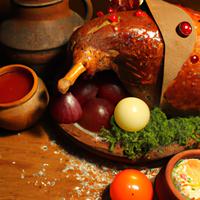
1 serving (100 grams) contains 200 calories, 25.0 grams of protein, 10.0 grams of fat, and 0.0 grams of carbohydrates.

Log this food in SnapCalorie

Nutrition Information
Calories |
476.2 | ||
|---|---|---|---|
% Daily Value* |
|||
| Total Fat | 23.8 g | 30% | |
| Saturated Fat | 7.1 g | 35% | |
| Polyunsaturated Fat | 0 g | ||
| Cholesterol | 190.5 mg | 63% | |
| Sodium | 166.7 mg | 7% | |
| Total Carbohydrates | 0 g | 0% | |
| Dietary Fiber | 0 g | 0% | |
| Sugars | 0 g | ||
| protein | 59.5 g | 119% | |
| Vitamin D | 0 mcg | 0% | |
| Calcium | 23.8 mg | 1% | |
| Iron | 6.4 mg | 35% | |
| Potassium | 595.2 mg | 12% | |
* Percent Daily Values are based on a 2,000 calorie diet. Your daily values may be higher or lower depending on your calorie needs.
Food Attributes
Source of Calories
About Entenbrust
Entenbrust, or duck breast, is a flavorful cut of poultry commonly found in European and Asian cuisines, particularly in French and Chinese dishes. Known for its rich, tender meat and crispy skin when prepared correctly, Entenbrust offers a unique culinary experience. It is protein-rich and contains essential vitamins and minerals such as iron, zinc, and B vitamins, which support energy metabolism and immune function. Duck breast is higher in fat compared to other poultry, with much of its fat concentrated in the skin. While the fats are primarily unsaturated, which can be beneficial in moderation, it’s important to keep portion sizes in mind for a balanced diet. Entenbrust can be prepared in a variety of ways, including pan-searing, roasting, or smoking, often accompanied by fruit-based sauces or aromatic spices that complement its robust flavor.



